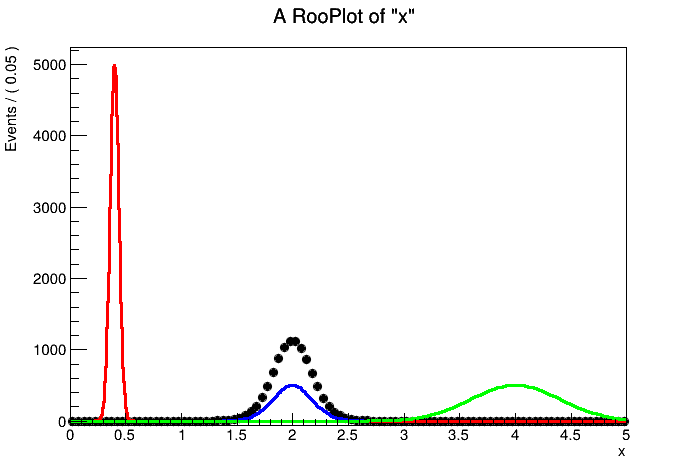Dear experts,
I’m trying to implement RooMomentMorphFuncND in ROOT 6.30/06 with Apple clang version 15.0.0.
I’m not sure I’ve implemented it properly, but the test code below creates a grid of 2D Gaussians at the corners of the grid, and I want to have the RooMomentMorphFuncND interpolate to an arbitary point in that space. The code is shown below.
const double X_MIN=0.;
const double X_MAX=5.;
const double Y_MIN=0.;
const double Y_MAX=4000.;
const double TX_MIN=0.4;
const double TX_MAX=4.0;
const double TY_MIN=200.;
const double TY_MAX=3000.;
const double TX_STEP=0.1;
const double TY_STEP=10;
const string concat(const string& s1, const string& s2)
{
return s1+s2;
}
RooProdPdf* create2DGauss(string name, RooRealVar& x, RooRealVar& y, double mean1, double mean2, double sigma1, double sigma2)
{
RooRealVar* mean1v=new RooRealVar(concat(name,"mean1").c_str(), "mean of Gaussian 1", mean1);
RooRealVar* mean2v=new RooRealVar(concat(name,"mean2").c_str(), "mean of Gaussian 2", mean2);
RooRealVar* sigma1v=new RooRealVar(concat(name,"sigma1").c_str(), "sigma of Gaussian 1", sigma1,1e-30,1e30);
RooRealVar* sigma2v=new RooRealVar(concat(name,"sigma2").c_str(), "sigma of Gaussian 2", sigma2,1e-30,1e30);
// Create the Gaussian PDF in x and y
RooGaussian* gaussX=new RooGaussian(concat(name,"gaussX").c_str(), "Gaussian in x", x, *mean1v, *sigma1v);
RooGaussian* gaussY=new RooGaussian(concat(name,"gaussY").c_str(), "Gaussian in y", y, *mean2v, *sigma2v);
// Create a 2D Gaussian PDF by multiplying the individual Gaussians
RooProdPdf *pdf= new RooProdPdf(concat(name,"gauss2D").c_str(), "2D Gaussian PDF", RooArgList(*gaussX, *gaussY));
return pdf;
}
int main(int argc, char* argv[])
{
TApplication app("myApp", nullptr, nullptr);
// observables
RooRealVar x("x", "x", X_MIN, X_MAX);
RooRealVar y("y", "y", Y_MIN, Y_MAX);
// theory parameters
RooRealVar tx("tx","tx",TX_MIN,TX_MAX);
RooRealVar ty("ty","ty",TY_MIN,TY_MAX);
// grid binning
RooBinning bintx((TX_MAX-TX_MIN)/TX_STEP,TX_MIN,TX_MAX);
RooBinning binty((TY_MAX-TY_MIN)/TY_STEP,TY_MIN,TY_MAX);
RooMomentMorphFuncND::Grid2 grid(bintx,binty);
double m_p, m_o;
m_o=TX_MIN; m_p=TY_MIN; grid.addPdf(*create2DGauss("G1",x,y,m_o,m_p,m_o*0.1,m_p*0.1),bintx.binNumber(m_o),binty.binNumber(m_p));
m_o=TX_MIN; m_p=TY_MAX; grid.addPdf(*create2DGauss("G2",x,y,m_o,m_p,m_o*0.1,m_p*0.1),bintx.binNumber(m_o),binty.binNumber(m_p));
m_o=TX_MAX; m_p=TY_MIN; grid.addPdf(*create2DGauss("G3",x,y,m_o,m_p,m_o*0.1,m_p*0.1),bintx.binNumber(m_o),binty.binNumber(m_p));
m_o=TX_MAX; m_p=TY_MAX; grid.addPdf(*create2DGauss("G4",x,y,m_o,m_p,m_o*0.1,m_p*0.1),bintx.binNumber(m_o),binty.binNumber(m_p));
RooMomentMorphFuncND morph("morph","morph",RooArgList(tx,ty),RooArgList(x,y),grid,RooMomentMorphFuncND::Linear);
morph.setPdfMode();
RooWrapperPdf pdf("morph_pdf","morph_pdf",morph,true);
// generate at a given point
tx.setVal(2);
ty.setVal(300);
TH2D* hist = new TH2D("hist", "hist", 100, X_MIN, X_MAX, 100, Y_MIN, Y_MAX);
pdf.generateBinned(RooArgSet(x,y),10000,true);
hist->Draw();
app.Run();
return 0;
}
I’m getting a series of errors, for instance:
[#0] ERROR:Eval -- RooAbsReal::logEvalError(morph_transVar_0_1) evaluation error,
origin : RooLinearVar::morph_transVar_0_1[ var=y slope=morph_slope_0_1 offset=morph_offset_0_1 ]
message : function value is NAN
server values: var=y=-520, slope=morph_slope_0_1=nan, offset=morph_offset_0_1=nan
Any help would be appreciated.
Best,
JP


